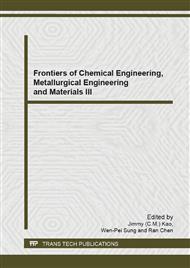[1]
Alp I, Deveci H, and Süngün H, Utilization of flotation wastes of copper slag as raw material in cement production. Journal of hazardous materials, 2008. 159(2): pp.390-395.
DOI: 10.1016/j.jhazmat.2008.02.056
Google Scholar
[2]
Carranza F, Iglesias N, Mazuelos A, Romero R, and Forcat O, Ferric leaching of copper slag flotation tailings. Minerals Engineering, 2009. 22(1): pp.107-110.
DOI: 10.1016/j.mineng.2008.04.010
Google Scholar
[3]
Gorai B and Jana R, Characteristics and utilisation of copper slag—a review. Resources, Conservation and Recycling, 2003. 39(4): pp.299-313.
DOI: 10.1016/s0921-3449(02)00171-4
Google Scholar
[4]
Shi C, Meyer C, and Behnood A, Utilization of copper slag in cement and concrete. Resources, Conservation and recycling, 2008. 52(10): pp.1115-1120.
DOI: 10.1016/j.resconrec.2008.06.008
Google Scholar
[5]
Al-Jabri K S, Hisada M, Al-Oraimi S K, and Al-Saidy A H, Copper slag as sand replacement for high performance concrete. Cement and Concrete Composites, 2009. 31(7): pp.483-488.
DOI: 10.1016/j.cemconcomp.2009.04.007
Google Scholar
[6]
Bao Z B, Jin D C, and Teng H J, Hazards and Treatment Methods of Large-Scale Livestock Sewage Pollution in China. Advanced Materials Research, 2013. 610: p.1954-(1957).
DOI: 10.4028/www.scientific.net/amr.610-613.1954
Google Scholar
[7]
Luo G Z, Xi C G, and Fu J S, Highways Construction and Optimal and Intensive Land Use. Advanced Materials Research, 2012. 599: pp.929-933.
DOI: 10.4028/www.scientific.net/amr.599.929
Google Scholar
[8]
Shen H and Forssberg E, An overview of recovery of metals from slags. Waste Management, 2003. 23(10): pp.933-949.
DOI: 10.1016/s0956-053x(02)00164-2
Google Scholar
[9]
Hou G, Li W, Guo W, Chen J, Luo J, and Wang J, Microstructure and Mineral Phase of Converter Slag. JOURNAL-CHINESE CERAMIC SOCIETY, 2008. 36(4): p.436.
Google Scholar
[10]
Altundogan H, Boyrazli M, and Tumen F, A study on the sulphuric acid leaching of copper converter slag in the presence of dichromate. Minerals engineering, 2004. 17(3): pp.465-467.
DOI: 10.1016/j.mineng.2003.11.002
Google Scholar
[11]
Rudnik E, Burzyńska L, and Gumowska W, Hydrometallurgical recovery of copper and cobalt from reduction-roasted copper converter slag. Minerals Engineering, 2009. 22(1): pp.88-95.
DOI: 10.1016/j.mineng.2008.04.016
Google Scholar
[12]
Moura W A, Gonçalves J P, and Lima M B L, Copper slag waste as a supplementary cementing material to concrete. Journal of materials science, 2007. 42(7): pp.2226-2230.
DOI: 10.1007/s10853-006-0997-4
Google Scholar
[13]
Shoaib M, Ahmed S, and Balaha M, Effect of fire and cooling mode on the properties of slag mortars. Cement and Concrete Research, 2001. 31(11): pp.1533-1538.
DOI: 10.1016/s0008-8846(01)00561-0
Google Scholar
[14]
Tossavainen M, Engstrom F, Yang Q, Menad N, Lidstrom Larsson M, and Bjorkman B, Characteristics of steel slag under different cooling conditions. Waste management, 2007. 27(10): pp.1335-1344.
DOI: 10.1016/j.wasman.2006.08.002
Google Scholar
[15]
Moustakas K, Mavropoulos A, Katsou E, Haralambous K-J, and Loizidou M, Leaching properties of slag generated by a gasification/vitrification unit: The role of pH, particle size, contact time and cooling method used. Journal of hazardous materials, 2012. 207: pp.44-50.
DOI: 10.1016/j.jhazmat.2011.09.070
Google Scholar


